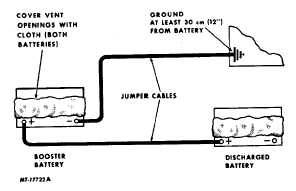|
| |
TRUCK SERVICE MANUAL
TM 5-4210-230-14&P-1
After cleaning, reinstall battery and hold down parts as
instructed under REMOVAL AND INSTALLATION. Coat
battery and cable terminals with terminal grease (IH part
number 472141C1) and connect cables to battery
terminals. Connect ground cable last.
3. On low maintenance (conventional) batteries check the
electrolyte level. If necessary, add odorless drinking
water to bring the liquid level to the level indicator. If the
battery does not have a level indicator, bring the level to
13 mm (1/2 inch) above the tops of the separators. Do
not overfill any cell. When a cell is overfilled, the excess
electrolyte may be forced from the cell by the gas formed
in the battery. This will cause excessive corrosion of
adjacent metal parts, reduced performance and shorter
life.
Frequent need for refilling battery cells may indicate that
battery is being overcharged. Check charging system
and readjust voltage regulator as needed.
Maintenance free type batteries do not require addition of
water under normal operating conditions. If loss of
electrolyte is suspected, check electrolyte level as
instructed under TESTING and determine cause for low
level.
EMERGENCY (JUMPER) STARTING
The procedure outlined below should be followed exactly if it
becomes necessary to use a booster battery to start a vehicle
with a discharged battery.
CAUTION
Both booster and discharged batteries must be
treated carefully when using jumper cables. Be
careful not to cause sparks. Observe all
precautionary measures listed under SAFETY
PRECAUTIONS.
Wear safety glasses or shield eyes.
Any procedure other than that outlined below could
result in 1) personal injury caused by electrolyte
squirting out the battery vent, 2) personal injury or
property damage due to battery explosion, 3)
damage to the charging system of the booster
vehicle or of the immobilized vehicle.
Make sure booster and discharged batteries are the same
voltage (6-volt or 12-volt).
Make certain the stalled vehicle and the one containing the
booster battery do not touch. If the two vehicles are in
contact, a ground connection could be established which
could cause sparking when jumper cables are attached.
1. On both vehicles: Set parking brake. Place transmission
in NEUTRAL or PARK. Turn lights, heater and other
electrical loads "OFF". Make certain ignition key is turned
"OFF".
2. Determine whether the discharged battery has the negative
(-) or positive (+) terminal grounded. The ground cable is
connected to the engine block, vehicle frame or other
good metallic ground. The battery terminal connected to
the starter relay is the one which is NOT grounded.
3. Be sure vent caps are tight on both batteries. Place a
damp cloth over the vents of each battery. Make certain
cloth is clear of fan blades, belts or other moving parts.
4. On negative ground vehicles, attach one end of the jumper
cable to the positive (+) terminal of the booster battery
and the other end of same cable to positive (+) terminal
of discharged battery (Figure 9).
On positive ground vehicles, connect jumper cable
between negative (-) battery terminals.
Fig. 9 Proper Jumper Cable Connections
(Negative Ground Vehicles Shown
CTS-2771 Page 9
PRINTED IN UNITED STATES OF AMERICA
|

